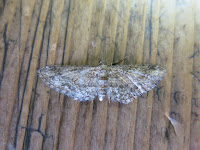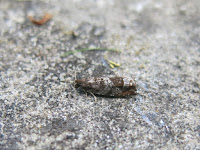A rich supporting cast included Narrow-winged Pug (5th Dingestow record and my first since 2007), 3 Slender Pug, 1 Slender Brindle and a Dark Swordgrass on 27/7, and Mocha, Small Waved Umber and Satin Beauty on 28/7.
Monday, 29 July 2019
Two nights, two new
A Double Lobed to MV at Dingestow Court on 27th July was new for the area, and I thought this was going to be star moth of the weekend. However, a mega Pine Hawkmoth was waiting for me in the trap after the night of 28th July. There is only one previous (unverified) Welsh record according to NBN: from Fishguard in Pembrokeshire in June 1982. There was a SW airflow on the night of 28th July 2019 and I suspect my Pine Hawkmoth came from continental Europe rather than England, although it's impossible to be sure.
A rich supporting cast included Narrow-winged Pug (5th Dingestow record and my first since 2007), 3 Slender Pug, 1 Slender Brindle and a Dark Swordgrass on 27/7, and Mocha, Small Waved Umber and Satin Beauty on 28/7.
A rich supporting cast included Narrow-winged Pug (5th Dingestow record and my first since 2007), 3 Slender Pug, 1 Slender Brindle and a Dark Swordgrass on 27/7, and Mocha, Small Waved Umber and Satin Beauty on 28/7.
Saturday, 27 July 2019
Small Mottled Willow and lots of Micros (edited)
A Small Mottled Willow to MV at Dingestow Court on 26th July was a welcome record of this migrant, especially as I missed the February 2019 influx here (though not in Carmarthenshire). None of the other 59 species of Macro were particularly exciting, although 10 Broad-bordered Yellow Underwing was a remarkable tally and it's always nice to see Maple Pug. In contrast, the Micros were outstanding, with 45 species including Caryocolum tricolorella, Ypsolopha scabrella, Acrobasis consociella, 2 Nomophila noctuella and 3 Plutella xylostella.
Best of all was a Biselachista that was initially thought to be B. utonella, but which turned out to be a male B. albidella with diagnostic projecting pointed ends to the valvae. The only previous county record of this species - which feeds on Cottongrass and a few other wetland graminoids - was from Cleddon Bog in 1999. It really was an unexpected addition to the Dingestow moth list!
Saturday, 20 July 2019
Catoptria margaritella and other wanderers
The distinctive Pearl-banded Grass-veneer (Catoptria margaritella) made its first Dingestow appearance at MV on 19th July. There are 7 previous Gwent records: four on the coast, one in Rogerstone and two in Usk. So far, nobody has found this bog/heath moth in a likely breeding habitat in VC35, although it is common in wetlands in Carmarthenshire and other parts of Wales. It is possible that the Dingestow individual wandered from Wentwood, as the wind was from the SSW, but the concentration of past records on the Gwent coast suggests that our C. margaritella originate from Exmoor or the Quantock Hills. It was accompanied by a Map-winged Swift and a True Lover's Knot, as well as a gorgeous Endotrichia flammealis.
Friday, 12 July 2019
Oak Eggar and other woodland species
Southerly winds seem to have brought a bunch of uncommon woodland moths to the Dingestow Court garden from the wooded ridge 1km to the south. Pick of the bunch was a huge female Oak Eggar (2nd record): a species I saw once in flight here in 2015 but otherwise didn't know occurred in the area. A Map-winged Swift was the 2nd Dingestow record, following one in Penyclawdd Wood in 2001, whilst my only previous Endotrichia flamealis was in Penyclawdd Wood in 2007. Satin Beauty was my 6th Dingestow record, but all five previous records were from the wooded ridge. Supporting cast included my 4th Grass Emerald, 5th Marbled Green, 6th Dingy Shears, an Eyed Hawk-moth and a Pammene fasciana. Finally and frustratingly an unfamiliar 'diagonal-banded cochylid' turned out to be a dark morph of Small Marbled - part of a big national influx - but escaped while I was trying to photograph it. All in all an excellent night!
Thursday, 11 July 2019
Marbled Green etc
I had a second chance with Marbled Green after one flew off from its photo shoot yesterday morning: another, greener one visited my MV on 10/7 (4th Dingestow record). A Homoeosoma sinuella was the first here since 2005 and only the 3rd Dingestow record, whilst Rhyacionia pinicolana was my 6th. 2 Bordered White and a Dioryctria abietella continued the conifers theme. A smart striped Oak Nycteoline was also nice to see.
Tuesday, 9 July 2019
More wanderers
A huge Ophion wasp was highlight at the Dingestow Court Actinic on 8th July - this Enicospilus inflexus had a 3cm long body, and is generally regarded as a parasite of Oak/Northern Eggar so is unlikely to be a Dingestow resident. Another Small Elephant Hawkmoth and another Sycamore were joined by 2 Aphelia viburnana (new for Dingestow, although they both flew off when I released them for photography), Dingestow's 3rd Marbled Green (ditto) and my first Black Arches, Shaded Broad-bar and Common Rustic agg of the year.
Sunday, 7 July 2019
Continuing good conditions (update)
Although winds have been from the north or west rather than the migrant-bringing south, early July nights have been reasonably warm and overcast and moth numbers and diversity at Dingestow have been good (by current standards). Red-necked Footman have appeared on three consecutive nights, along with wanderers such as Phtheochroa inopiana (Fleabane), Calamotropha paludella (Reed), Wood Carpet, Double Dart and Lilac Beauty. All have fewer than 10 previous Dingestow records. Late summer moths are already appearing: Lesser Broad-bordered Yellow Underwing and Svensson's Copper Underwing were new for the year on 6/7. Star of the show, however, was a gen det female Scoparia basistrigalis, new for Dingestow (my 536th Micro) on 6/7. It doesn't look like much in the photo, but in the flesh it was big, and the markings all fitted this uncommon species including the black terminal dots. I have caught a few potential basistrigalis in the Wye Valley in the past, all of which proved to be the common S. ambigualis when dissected, so I was pleased that this was finally the real thing.
Saturday, 6 July 2019
Local wanderers
Excellent trapping conditions at Dingestow on the night of 4th July produced nearly 100 moth species, including four with fewer than 5 previous Dingestow records. These were my 3rd Small Elephant Hawkmoth, 3rd Sycamore, 4th Red-necked Footman (2 more appeared on 5/7) and 3rd Coleophora albidella. Also nice were Metzneria metzneriella and Ancylis achatana.
Scarce Light Plume at Dingestow
The late June heatwave brought an influx of Crombrugghia laetus (Scarce Light Plume) to Britain. This species breeds in Mediterranean Europe and North Africa and is generally a rare visitor to Britain, with most records coming from the west. The majority of the 2019 arrivals were south-western too, although there was a scattering of records inland.
I was thrilled to find a female (gen. conf.) C. laetus in my MV at Dingestow Court on the night of 30th June - not only is it Dingestow's first confirmed record of this species, it also exorcises the ghost of a probable C. laetus that I caught at Dingestow on 23rd June 2000 and sketched in my notebook (before the days of good digital cameras). There is one previous confirmed VC35 record: Roger Gaunt caught one at Livox on 26th June 2000. My 2000 Dingestow sketch was made before I was aware of Roger's catch, and when I thought that only three small, orange, white-banded plumes (genus Oxyptilus) occurred in Britain. I am 99.9% sure that my first record was also C. laetus, and that an influx to western Britain also occurred in late June 2000, although the British records on the Mothscount website don't show any others for 2000.

Subscribe to:
Posts (Atom)













































